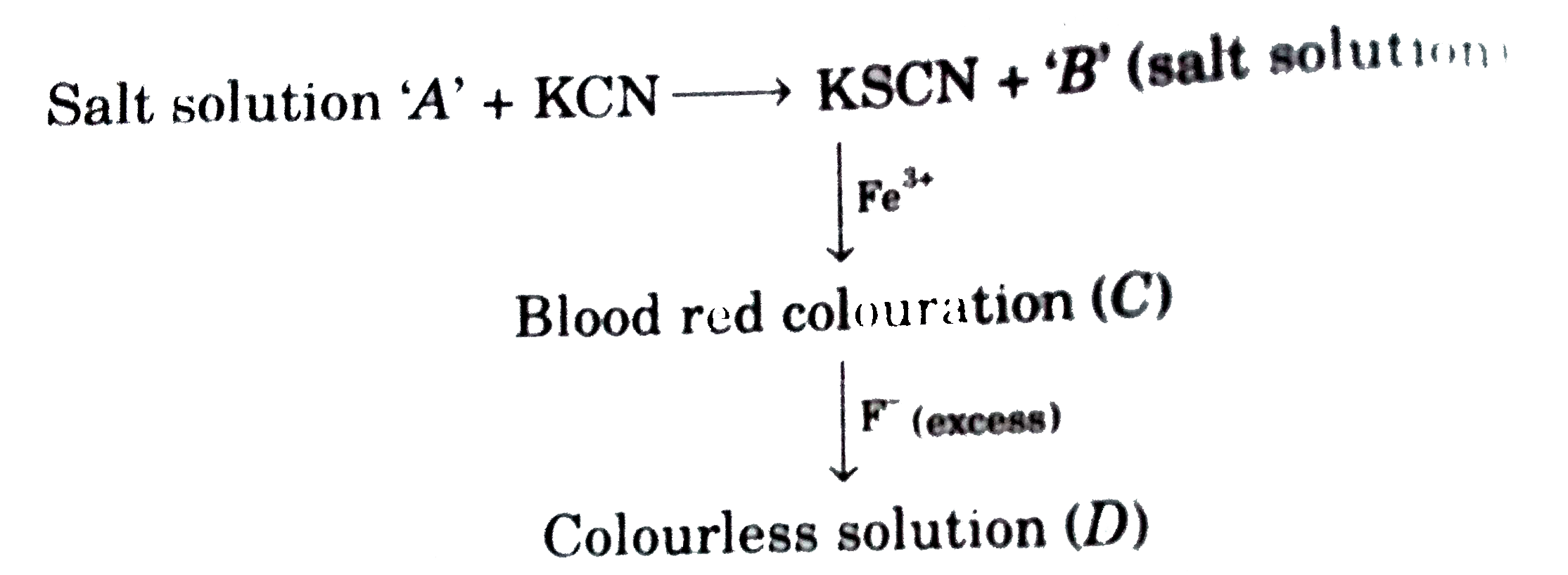Mn2+ forms a complex with Br– ion. The magnetic moment of the complex is 5.92 B. M. What could not be the probable formula and geometry of the complex?
[MnBr6]4−, octahedral
[MnBr4]2− square planner
[MnBr4]2− tetrahedral
[MnBr5]3− trigonal bipyramidal
The correct Answer is:B
To solve the problem, we need to analyze the magnetic moment of the complex formed by Mn2+ and Br− ions, and determine the probable formula and geometry of the complex.
1. Understanding Magnetic Moment:
The magnetic moment (μ) is given by the formula:
μ=√n(n+2)
where n is the number of unpaired electrons.
2. Given Magnetic Moment:
We are given that the magnetic moment of the complex is 5.92B.M..
3. Calculating n:
We will square the magnetic moment to find n:
(5.92)2=n(n+2)
35=n2+2n
Rearranging gives us:
n2+2n−35=0
4. Solving the Quadratic Equation:
We can solve this quadratic equation using the quadratic formula:
n=−b±√b2−4ac2a
Here, a=1,b=2,c=−35:
n=−2±√(2)2−4⋅1⋅(−35)2⋅1
n=−2±√4+1402
n=−2±√1442
n=−2±122
This gives us two possible values for n:
n=5(taking the positive root)
5. Determining the Electron Configuration:
The electron configuration for Mn2+ (which has lost two electrons) is:
Mn2+:(Ar)3d5
Since n=5, all five electrons in the 3d subshell are unpaired.
6. Analyzing Possible Complexes:
We need to determine the possible formulas and geometries for the complexes formed with Br−:
- For MnBr4−6:
- Mn2+ has an oxidation state of +2, and Br− is a weak field ligand. The geometry would be octahedral.
- For MnBr2−4:
- Similar analysis shows that it would also likely be octahedral, but with fewer ligands.
- For MnBr3−5:
- This would lead to a trigonal bipyramidal geometry, which is consistent with the unpaired electrons.
7. Identifying the Incorrect Option:
The geometry and electronic configuration must match the number of unpaired electrons and the nature of the ligands. The geometry of MnBr2−4 cannot be square planar because Br− is a weak field ligand and does not cause pairing of electrons. Thus, the geometry cannot be square planar.
Conclusion:
The probable formula and geometry that could NOT be correct for the complex formed by Mn2+ and Br− is:
- Formula: MnBr2−4
- Geometry: Square planar
The magnetic moment (μ) is given by the formula:
μ=√n(n+2)
where n is the number of unpaired electrons.
We are given that the magnetic moment of the complex is 5.92B.M..
We will square the magnetic moment to find n:
(5.92)2=n(n+2)
35=n2+2n
Rearranging gives us:
n2+2n−35=0
We can solve this quadratic equation using the quadratic formula:
n=−b±√b2−4ac2a
Here, a=1,b=2,c=−35:
n=−2±√(2)2−4⋅1⋅(−35)2⋅1
n=−2±√4+1402
n=−2±√1442
n=−2±122
This gives us two possible values for n:
n=5(taking the positive root)
The electron configuration for Mn2+ (which has lost two electrons) is:
Mn2+:(Ar)3d5
Since n=5, all five electrons in the 3d subshell are unpaired.
We need to determine the possible formulas and geometries for the complexes formed with Br−:
- For MnBr4−6:
- Mn2+ has an oxidation state of +2, and Br− is a weak field ligand. The geometry would be octahedral.
- For MnBr2−4:
- Similar analysis shows that it would also likely be octahedral, but with fewer ligands.
- For MnBr3−5:
- This would lead to a trigonal bipyramidal geometry, which is consistent with the unpaired electrons.
The geometry and electronic configuration must match the number of unpaired electrons and the nature of the ligands. The geometry of MnBr2−4 cannot be square planar because Br− is a weak field ligand and does not cause pairing of electrons. Thus, the geometry cannot be square planar.
The probable formula and geometry that could NOT be correct for the complex formed by Mn2+ and Br− is:
- Formula: MnBr2−4
- Geometry: Square planar
Topper's Solved these Questions
- COORDINATION COMPOUNDBook:MOTIONChapter:COORDINATION COMPOUNDExercise:EXERCISE-2 (LEVEL -II) MULTIPLE CORRECT JEE ADVANCED Match the Column
Explore 10 Videos
- COORDINATION COMPOUNDBook:MOTIONChapter:COORDINATION COMPOUNDExercise:EXERCISE -3 SUBJECTIVE JEE ADVANCED
Explore 40 Videos
- COORDINATION COMPOUNDBook:MOTIONChapter:COORDINATION COMPOUNDExercise:EXERCISE -2 (LEVEL I) OBJECTIVE PROBLEMS JEE MAIN
Explore 60 Videos
- CLASSROOM PROBLEMS 1Book:MOTIONChapter:CLASSROOM PROBLEMS 1Exercise:THERMODYNAMICS
Explore 17 Videos
- D-BLOCK ELEMENTS Book:MOTIONChapter:D-BLOCK ELEMENTS Exercise:Exercise IV Level-II
Explore 9 Videos
Similar Questions
Knowledge Check
Mn2+ forms a complex with Br– ion. The magnetic moment of the complex is 5.92 B. M. What could not be the probable formula and geometry of the complex?
A[MrBr6]4−, octahedralB[MnBr4]2−, square planarC[MnBr4]2− , tetrahedralD[MnBr5]3− , trigonal bipyramidal
The magnetic moment of complex 'C' is:A1.7B.M.B3.87B.MC2.83B.MD5.92B.MThe magnetic moment of a complex ion is 2.83 BM. The complex ion is :
A[V(H2O)6]3+B[Cr(H2O)6]3+C[Cu(CN)4]2−D[MnCl4]2−
The complexes that have a magnetic moment of 1.73 BM is
View SolutionThe magnetic moment of the complex [Ti(H2O)6]3+ is
View SolutionThe magnetic moment of a complex ion is 1.73 BM. The complex ion is __________.
View SolutionThe complex showing a spin-only magnetic moment of 2,82 B.M. is
View SolutionThe complex showing a spin-only magnetic moment of 2,82 B.M. is
View Solution

